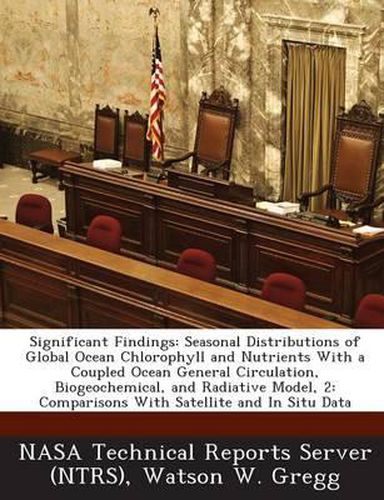Readings Newsletter
Become a Readings Member to make your shopping experience even easier.
Sign in or sign up for free!
You’re not far away from qualifying for FREE standard shipping within Australia
You’ve qualified for FREE standard shipping within Australia
The cart is loading…






A coupled ocean general circulation, biogeochemical, and radiative model was constructed to evaluate and understand the nature of seasonal variability of chlorophyll and nutrients in the global oceans. Biogeochemical processes in the model were determined from the influences of circulation and turbulence dynamics, irradiance availability, and the interactions among three functional phytoplankton groups (diatoms, chlorophytes, and picoplankton) and three nutrients (nitrate, ammonium, and silicate). Basin scale (>1000 km) model chlorophyll seasonal distributions were statistically positively correlated with CZCS chlorophyll in 10 of 12 major oceanographic regions, and with SeaWiFS in all 12. Notable disparities in magnitudes occurred, however, in the tropical Pacific, the spring/summer bloom in the Antarctic, autumn in the northern high latitudes, and during the southwest monsoon in the North Indian Ocean. Synoptic scale (100-1000 km) comparisons of satellite and in situ data exhibited broad agreement, although occasional departures were apparent. Model nitrate distributions agreed with in situ data, including seasonal dynamics, except for the equatorial Atlantic. The overall agreement of the model with satellite and in situ data sources indicated that the model dynamics offer a reasonably realistic simulation of phytoplankton and nutrient dynamics on basin and synoptic scales.
$9.00 standard shipping within Australia
FREE standard shipping within Australia for orders over $100.00
Express & International shipping calculated at checkout
A coupled ocean general circulation, biogeochemical, and radiative model was constructed to evaluate and understand the nature of seasonal variability of chlorophyll and nutrients in the global oceans. Biogeochemical processes in the model were determined from the influences of circulation and turbulence dynamics, irradiance availability, and the interactions among three functional phytoplankton groups (diatoms, chlorophytes, and picoplankton) and three nutrients (nitrate, ammonium, and silicate). Basin scale (>1000 km) model chlorophyll seasonal distributions were statistically positively correlated with CZCS chlorophyll in 10 of 12 major oceanographic regions, and with SeaWiFS in all 12. Notable disparities in magnitudes occurred, however, in the tropical Pacific, the spring/summer bloom in the Antarctic, autumn in the northern high latitudes, and during the southwest monsoon in the North Indian Ocean. Synoptic scale (100-1000 km) comparisons of satellite and in situ data exhibited broad agreement, although occasional departures were apparent. Model nitrate distributions agreed with in situ data, including seasonal dynamics, except for the equatorial Atlantic. The overall agreement of the model with satellite and in situ data sources indicated that the model dynamics offer a reasonably realistic simulation of phytoplankton and nutrient dynamics on basin and synoptic scales.